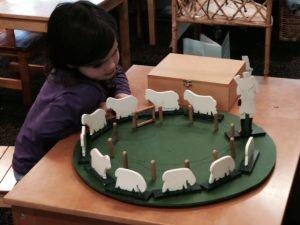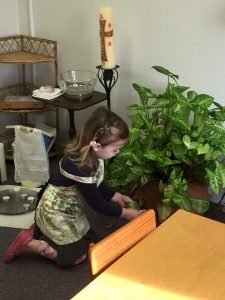Characteristic #3 and a Look at Practical Life in the Atrium
Characteristic #3
The atrium is a community in which children and adults live together a religious experience which facilitates participation in the wider community of the family, the church and other social spheres.
-
The atrium is a place of prayer, in which work and study spontaneously become meditation, contemplation and prayer.
-
The atrium is a place in which the only Teacher is Christ; both children and adults place themselves in a listening stance before his Word and seek to penetrate the mystery of the liturgical celebration.
 Often, adults who work in an atrium environment find they have favorite works or ones they consider more important than other works. There are times when I have overheard people mention the works of practical life and care for the environment as noisy work or busy work and the real work is the scripture and liturgical work.
Often, adults who work in an atrium environment find they have favorite works or ones they consider more important than other works. There are times when I have overheard people mention the works of practical life and care for the environment as noisy work or busy work and the real work is the scripture and liturgical work.
Maria Montessori did not see it that way. She said: “The child becomes a person through work.”
One of the reflections we give in formation of catechists is about the importance of practical life as an indirect aid to prayer. Through working with their hands in a concentrated and meaningful way the internalize the ability to listen and respond to the voice of Jesus the Good Shepherd.

The work of the child is important whether it be liturgical work, scripture or practical life. We cannot measure their work by output or how many different presentations we have managed to get through this term or year. We must with great patience and humility, observe the work of the child waiting for a sign of what they next need from us. The adult is not the teacher, we act merely as a resource a guide for the child. God is the teacher and the environment is the means through which he teaches.

Below are some quotes about practical life, one from Maria Montessori and one from Gianna Gobbi.
“When we speak about the behaviour of men and animals, we refer to their purposeful movements. This behaviour is the centre of their practical life. It is not just the practical life in a house, cleaning rooms, watering plants, etc., that is important, but the fact that everyone in the world must move with a purpose and must work, not only for himself but also for others. It is strange that man’s work must also be work in service of others; if this were not so, his work would have no more meaning than gymnastic exercises. All work is done not only for ourselves but also for others. Even something as frivolous as dancing would be pointless without an audience. The dancers, who perfect their movements with so much trouble and fatigue, dance for others. Tailors who spend their lives sewing could not wear all the clothes they make themselves. Yet tailoring, like gymnastics, requires lots of movements.
If you have a vision of the cosmic purpose, that every life in the world is based on this movement with a purpose, you will be able to understand and better direct the children’s work. In the beginning, children are urged by nature to be active. They are happy when they are active. They begin to develop the behaviour of humanity with its limits and its possibilities.”
Montessori, Maria. The 1946 London Lectures.

“It is very important that we adults not view the practical life activities merely as the duty or personal responsibility of the child in helping to keep the environment in good order. Rather, we must understand that the practical life activities fulfill a deep need in the child (especially in the younger child) and also are directly connected to the religious life of the child.”
Gianna Gobbi. Listening to God with Children